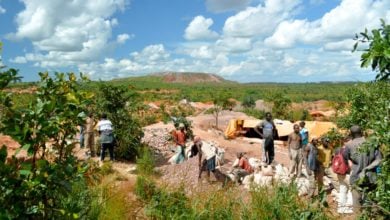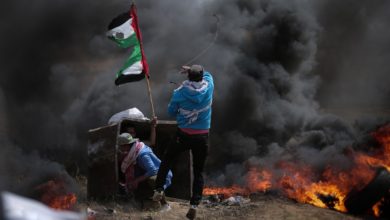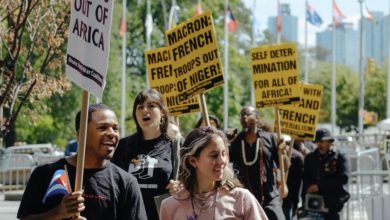In a sign of the increasing tempo of struggle in South Africa, Gold Fields, the fourth largest gold producer, evicted 5,000 workers from company-owned housing in a reprisal against striking miners who have crippled the company’s profit-making operations. Also in early October, South African mine owner Anglo American Platinum (AmPlats) announced that it had fired 12,000 miners after a protracted strike.
In addition to continued rebelliousness amongst mineworkers, who are putting down tools en masse across the nation, the Congress of South African Trade Unions, the national union federation, has demanded that mine owners renegotiate contracts a year early for 120,000 workers. With workers and bosses ensconced behind their respective barricades, the mine pits have become a battlefield in a war to resolve contradictions sharpened by the fall of apartheid.
The previous article in this series on South Africa described how the resistance of the Black masses intensified the contradictions inside the apartheid capitalist state, forcing the ruling party to the negotiating table. What led the liberation forces to embrace negotiations? Moreover, what concessions were made, who made them, and can the negotiations process be described, as some do, as a betrayal of the goals of the liberation movement? Answering these questions and examining the policies of the first post-apartheid government are crucial to understanding the outlines of the current structure of South Africa’s capitalist society.
At the negotiating table
While the forces of the apartheid government had been humbled by the mass struggle, they were far from defeated and possessed a powerful security apparatus. The African National Congress—allying the Communist Party, COSATU and bourgeois nationalist forces—and Pan African Congress possessed limited military capabilities. Both organizations had adopted what was essentially a hit-and-run strategy involving occasional bombings and acts of sabotage combined with mass protests focused on reducing the legitimacy of the apartheid regime and strengthening the anti-apartheid movement.
There was no truly “liberated” territory, and the masses of Black people were not armed or trained in military tactics. Further, while not a majority, there were significant elements with their own armed forces, such as the Inkatha Freedom Party in Zululand, led by the Zulu king, that were opposed to the liberation movement and open to collaboration with the apartheid regime.
Another key factor was the role of the Soviet Union and East European socialist countries. The ANC drew substantial material aid from these socialist bloc countries, which provided the principal support for the ANC’s armed wing, Umkhonto we Sizwe.
However, in the 1980s the Gorbachev leadership of the USSR began a further retreat from confrontation with imperialism. In southern Africa, this meant that the Soviet Union favored negotiations leading to compromise by the liberation movement. After the overthrow of the USSR and the socialist bloc countries, the ANC lost their principal military supporter completely. These two factors increasingly handicapped their ability to escalate the armed struggle, even if they had chosen to do so.
The PAC, which had never had as much international material support as the ANC, was in a similar position. While there was a stalemate between the liberation forces and the apartheid regime, in the short term any escalation of armed struggle favored the apartheid forces.
Realistically, by 1990 there were only two paths. One was some form of negotiations, during which liberation forces could leverage their ability to disrupt capitalist profit-making to obtain concessions, including an end to apartheid. The other was an all-out struggle to overthrow the capitalist apartheid regime completely.
An all-out struggle would have required a continued armed struggle with almost no military resources, combined with continued mass mobilizations. However, losses inflicted on the Black community would have been significant. The two-pronged policy of co-option and war on the part of the apartheid government could have led significant sectors of the Black masses to back collaborationist parties out of war-weariness. As a consequence, mass support for the liberation movement could have weakened, making further struggle even harder.
In addition, base areas outside the country could not necessarily be secured, given that South African incursions had taken a devastating toll on the surrounding countries as well. This had happened to such a degree that in 1984 Mozambique signed a peace accord with the apartheid regime to spare itself from vicious attacks. A similar occurrence in any of the African states neighboring South Africa could not be ruled out.
Thus the liberation forces were confronted with either attempting to leverage their relative advantages in hopes of achieving a compromise or gambling everything in what would be an extremely bloody civil war. While one can plausibly debate both strategies, in retrospect accusations of “betrayal” seem to be hyperbole. Principled revolutionary struggle has never ruled out compromise, even of the bitterest kind.
This meant the ANC and other liberation forces that agreed to negotiations did so from a position of relative weakness. De Klerk and the National Party wanted a proportional system where whites would maintain significant representation in the legislature and the government, “sharing” power with the overwhelmingly Black majority. A significant part of NP strategy was to make the Black population appear to be incapable of self-governing. Thus state security forces armed the Inkatha Freedom Party, which was engaged in clashes with ANC cadre. Additionally, the security forces facilitated a wave of criminal violence in the townships.
In 1993, Chris Hani, a Communist and the second-most popular Black leader (after ANC leader Nelson Mandela), was gunned down in his own driveway by a racist armed by a white member of Parliament. While later investigations did not reveal any assassination conspiracy by foreign or racist forces, it is clear that the broader climate of anti-Black violence emboldened Hani’s killers to take such a provocative action.
Gains won
The ANC strategy bore significant fruit. Workers’ actions were able to raise issues of workers’ rights and provision of social services, even enshrining them to some extent in the constitution and in post-apartheid ANC policy proposals. The basic balance of forces during the negotiations period, however, did not shift decisively to either side’s advantage. White intransigence created a set of “red-lines” that Blacks were implicitly warned not to cross in their demands. Still, through negotiations backed up by continued mass struggle, the ANC was able to win concessions, in particular getting rid of apartheid and establishing the principle of majority rule.
There was, however, no real attempt at land redistribution, and control of the military was ceded to the former apartheid general staff. The monopoly capitalist structure of the economy was left intact, despite the stated aims of the ANC Freedom Charter, which included as a goal establishing public ownership of mineral wealth, the banks and monopoly industry.
Regarding the latter it is worth pointing out that international economic blackmail played a role. Foreign investment would have been severely curtailed had there been any deviation from the neoliberal fundamentalism being peddled from the imperialist capitals.
On balance then, negotiations were a logical choice at that time given the objective conditions. The ANC sought to maintain stability, avoiding a racist counterrevolution while bringing apartheid to an end and winning important democratic gains—majority rule, the right of workers to organize unions, and the ability to spend state revenues on social services to meet the needs of the majority.
The next article in this series will examine the strategy of white capital to economically co-opt leaders of the liberation movement further impacting the strategic line of the liberation forces. This capitalist strategy was made possible by the existence of diverse class elements inside the liberation movement.





